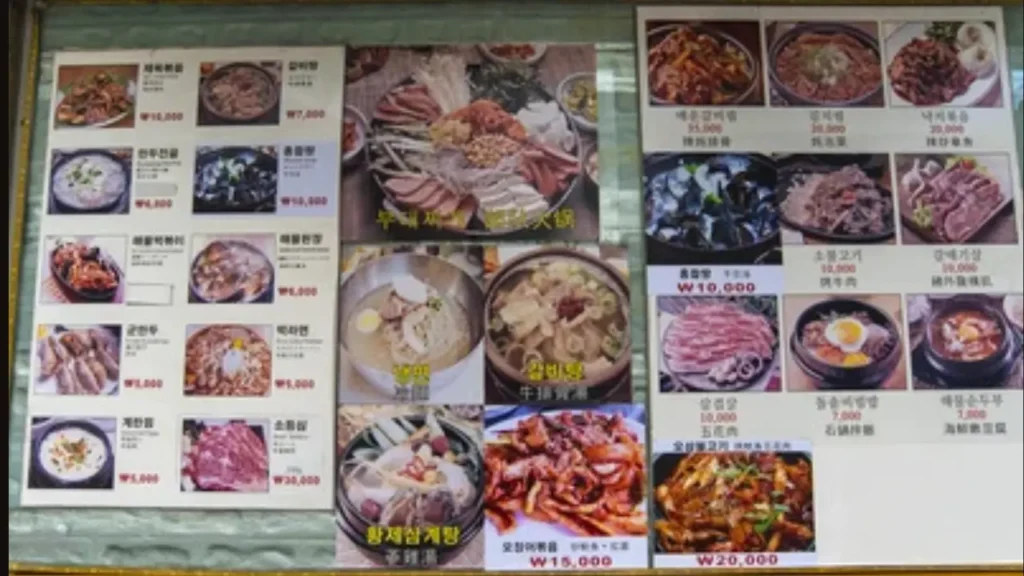Every traveler or new resident quickly feels the pinch of living costs. Therefore, understanding food price in Korea helps you plan wisely. In Seoul, groceries and restaurant meals cost more than in many Asian neighbors. Even so, you can still eat well without draining your wallet, provided you know the local tricks.

Staple Groceries Rice, Bread, and Eggs
Rice remains Korea’s food heart, and a pound averages ₩1,900. Local bakeries sell a one-pound loaf for ₩3,800, while a dozen eggs cost about ₩4,100. Because these staples appear in most meals, their steady prices keep the overall food price in korea relatively predictable.
Meat and Seafood

Korean cuisine relies on meat cuts and fresh fish. Chicken breast runs near ₩5,800 per pound, and pork belly hits ₩7,600. However, prime beef steaks can surge past ₩30,000 per pound, pushing the average food price in korea higher. Coastal markets offer fish at friendlier rates, yet imported salmon still carries a premium.
Fresh Produce Prices
Farmers’ markets overflow with cabbage, peppers, and apples. In autumn, a big napa cabbage head drops to ₩2,000, letting households make kimchi cheaply. Conversely, strawberries in winter can cost ₩9,000 for a single pound, showing how seasonal swings shape It.
Snacks and Instant Noodles

K-pop fans love convenience stores because snacks sit on every corner. A cup ramen bowl costs ₩1,200, while chocolate pies hover near ₩4,500 for a six-pack. Since kids and students snack often, steady shelf prices help keep food price in korea stable for budget eaters.
Dining Out
Seoul’s food stalls serve tteok-bokki for ₩5,000. In contrast, a casual restaurant bibimbap averages ₩9,500. A mid-range dinner for two climbs to ₩40,000, yet fast-food combos stay around ₩7,900. These wide choices let you tailor your daily price to your pocket.
Regional Differences
Busan’s coastal fish markets beat inland cities on seafood pricing. In smaller towns, local eateries still give side dishes for free, trimming meal costs. Because rent and labor remain lower outside Seoul, overall price falls by about fifteen percent once you leave the capital.
Monthly Food Budget
A student cooking most meals spends roughly ₩550,000 per month on groceries. In contrast, an office worker eating out twice daily can reach ₩900,000. Keeping breakfast simple and grabbing street snacks helps maintain a balanced price without sacrificing taste.
| Item (per pound or unit) | Average Price (₩) | Approx. USD* |
|---|---|---|
| Rice (1 lb) | 1,900 | 1.40 |
| Eggs (12) | 4,100 | 3.00 |
| Chicken breast (1 lb) | 5,800 | 4.30 |
| Pork belly (1 lb) | 7,600 | 5.70 |
| Fresh salmon (1 lb) | 13,000 | 9.70 |
| Bibimbap (restaurant) | 9,500 | 7.10 |
| Fast-food combo | 7,900 | 5.90 |
| *USD values use ₩1,350 = $1 for easy reference. |
Simple Tips to Cut Daily Costs
First, visit morning street markets for markdown produce that vendors must sell quickly. Next, choose canteens near universities, because they offer balanced meals for ₩5,000. Finally, cooking shared dinners with roommates spreads the food price in korea across more plates, keeping everyone happy and full.
Final Thoughts
Although Korea may seem pricey, smart shoppers eat well without overspending. Monitoring seasonal sales, exploring regional stalls, and blending home cooking with occasional treats keeps your food price in korea under control. Plan, stay flexible, and you will enjoy flavorful meals while still saving won for new adventures.
Leave a Reply